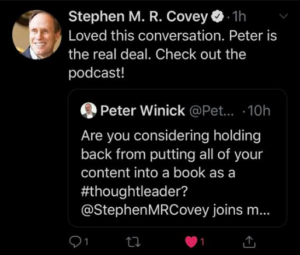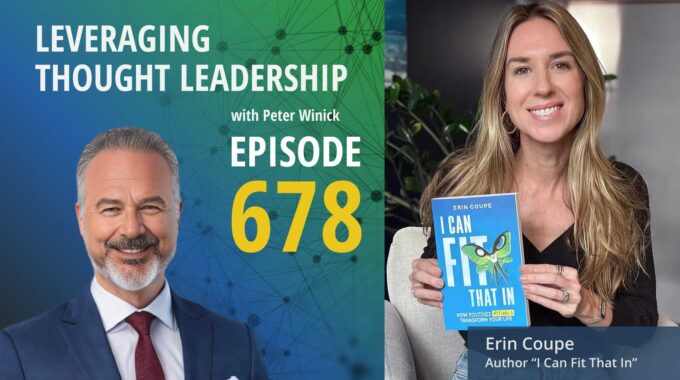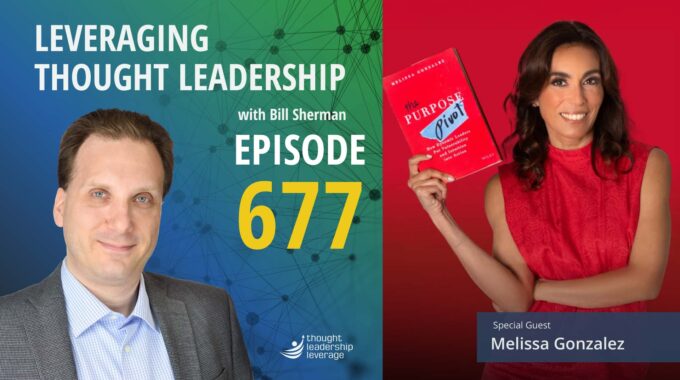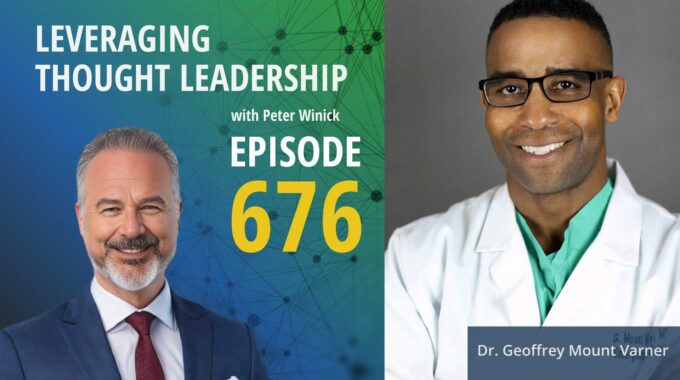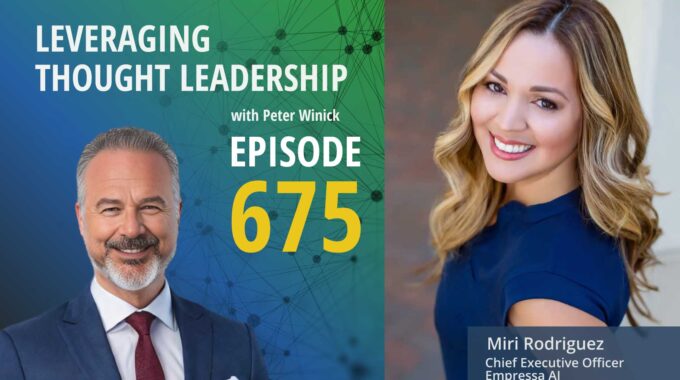A conversation on clarity, boundaries, and leadership that lasts. This episode explores how leaders and…
Leveraging Thought Leadership With Peter Winick – Episode 33 – Stephen M. R. Covey
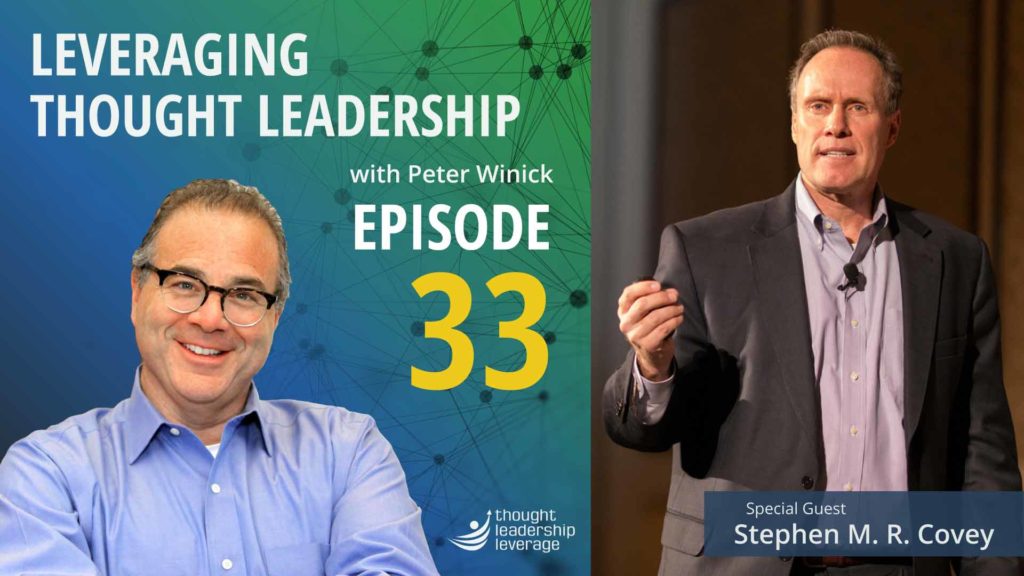
We all know that thought Leaders have a lot of great ideas, and that often translates into piles and piles of content! Do you know why you might not want to try and fit all that content into a single book?
This episode, TLL proudly welcomes Stephen M. R. Covey, author of “The Speed of Trust,” and co-founder and CEO of CoveyLink. Stephen sits down with Peter to talk about putting your content out into the world, how to find the right modality for your audience, and how to make your margin by serving your mission. Listen in and find out how!
If you need a strategy to bring your thought leadership to market, Thought Leadership Leverage can assist you! Contact us for more information. In addition, we can help you implement marketing, research, and sales. Let us help you so you can devote yourself to what you do best.

Transcript
Peter Winick And welcome, welcome, this is Peter Winnick. I’m the founder and CEO of Thought Leadership Leverage. And you are joining us today on our podcast, Leveraging Thought Leadership. My guest today, I’m really excited about this and I hope you are as well, is Stephen M.R. Covey. So I’ll give you the introduction, not that he necessarily needs one, but Stephen is the co-founder of Coveylink and the FranklinCovey Global Speed of Trust Practice. He’s the former CEO of Covey Leadership. He’s a Harvard MBA, he’s the author of The Speed of Trust. and he is well-versed in the business, which is actually a family business for him, of content. So Stephen, thank you so much for joining us today, and I’m so excited for all that we’re gonna talk about today. Welcome.
Stephen M. R. Covey Hey, thanks so much, Peter. I’m delighted to be with you and excited about this conversation as well.
Peter Winick Great. As you know, our focus here is on the business side of content and the business side of thought leadership. You and I were just chatting before we went live. Given that there are very few people that I know of that this is sort of a family business, why don’t we go back and tell me sort of how you started on the businesses side of content and thought leadership with your dad, with Stephen Covey and 7 Habits, and developed into a thought leader on your own and the similarities and the differences in the business models and how much things have changed. I’m sure there’s a lot we to learn, but. maybe gives a bit of a sort of a history lesson. Let’s go back in time a bit.
Stephen M. R. Covey Sure. In fact, I think it’s really quite instructive, as you’ll see how much today we assume and take for granted that we didn’t back when we started. And so I’ll just give you one example of this, Peter, is my father was working on his book, The Seven Habits of Highly Effective People, during the 1980s. And in fact, he started teaching seven habits as seven habits. I think the earliest we found was 1979. We saw it titled The Seven habits of highly affected people. And then over the next several years, he tried to, you know, he put out some audio tapes on it, which was really helpful to kind of have a product and more than just a speech. And then the thought was, you know let’s turn this into a book. And today that seems like, of course, right? That of course you’d do that. And I’ll tell you what, at the time we actually had some business advisors consultants that were saying, you know what? Don’t put this into a book. If you turn this into book.
Peter Winick Who’s gonna hire you? I love that point because even today on occasion, I get some of that pushback from clients where they’ll say, oh no, no, I can’t give them all of my information in a book because a book is only $20 and then why would they ever hire me? And my retort to them actually is, well, if you actually read Seven Habits, he didn’t only publish three of them. And from what I recall, I think that book went on to do okay, right?
Stephen M. R. Covey it went on to do okay. And, but the thing is that, honestly, there was some real debate, even inside the company of a, you know, do we put this into a book and put it out there? Will people still want us to come speak and train and can present, you now, can present and can sold all the things that we do. And, and, but my father really, apart from the business side, he was really acting on the principle of abundance. He said, look, I just want to get it out here. and the book’s gonna get it out there and. And he said, you know what? This will come back a hundred times and more. And he was right. And it looks obvious today, but at the time it wasn’t so clear cut and obvious. And I’m sure for some of our listeners, you still could have that dilemma. Is there a risk in doing this? But by codifying it in the form of a book, you kind of make, you stake your claim of, this is our approach. This is our methodology. This is what this is about. and we get it out there, and then that exposes people to it. They read it, they’re influenced by it, and they say, wow, this is really good, this can help me, and I need more help with this, or our team needs more help, our company needs more help, and really, the business at Covey Leadership Center really exploded once the Seven Habits of Highly Effective People was published as a book. And prior to that, we’d done some productizing. we had audio tapes, we even had a video-based training program, and that was really helpful because we began to scale ourselves and depend less upon my father having to go out and teach it live and instead we could have other people teach it and then we could also get even the clients to teach it, you know, a certification model with licensing and that was kind of new at the time as well.
Peter Winick So let’s talk about all of it, because there’s a lot there. So number one, you mentioned the book, and then audio tapes, and video tapes. So today we have different formats, digital, but the whole point was to take the essence, and the gist, and the message that’s in the book and get it out into as many modalities as you can. To A, to your point on your dad’s beliefs around abundance, to get the message out, it’s a good thing to do, right? But it’s also a good to do for the business. And then… you moved into sort of other ways that we can scale the content, right? So from speaking to workshops, to train the trainers and clients doing it, to the kit that you’ve developed, which is wonderful, the Speed of Trust in a Box Facilitator Guide. Tell me, you know, it’s all the same, meaning it all comes from the same DNA of the same content, but there are different markets and different price points and different modalities for different types of customers. So tell me a little bit about how you and the organization decide what modality to put it in and what market that serves and how to not cannibalize and deal with all those sort of struggles and issues.
Stephen M. R. Covey Yeah, yeah. And those are real issues. And, you know, I come back to the paradigm first, and truly if the paradigm is one of abundance, you will see possibilities and opportunities you may not see otherwise. And so the paradigm does matter. And that you really believe that we want to impact people. Our motive, our primary motive is to help people to bless lives, to get this out there, because it will help people. And I really believe that is important.
Peter Winick And I know you do. So let me just touch on that. So, let’s freeze the business side. And just at a human level, the more people that get exposed to your work and your dad’s work, you know, the world’s a better place, right? Because you’re teaching them habits that are great. You’re teaching people how to embrace a mindset of trust. And that’s just good, right. And then it merges into the business. But it’s just good to get good stuff out into the world, and gratifying on many levels.
Stephen M. R. Covey good, it’s gratifying, you feel like you’re part of something that is meaningful, that makes a difference. You’re making a contribution and especially if you feel strong about your content, which I’m sure your listeners do. When you feel strong about something and you really feel like this works and it’s effective and it can make a difference, you want to get it out to people. So that is the mindset and the paradigm. And the reason that’s important is because that helps you kind of wrestle with some of the dilemmas of saying, you know, what about the risk of this? And what about risk of cannibalization? If your fundamental paradigm is, you what, I want to impact people, I wanna get this out, then suddenly you have more courage to take some risk and you maybe say, you know what, that’s okay, maybe we do cannibalize a little bit here, but that’s okay because we’re getting this out there. and that was a dominant mindset. And we still had to figure out a number of other business decisions, but the belief was that it would come back around and it has. And then we tried to find ways to target different audiences and you know, who’s the audience? Who could benefit from this? Always starting with mission. Mission first, always. saying, okay, what is the, who is this audience that could benefit? And how might they, you know, what modality might serve them best? And there might be multiple modalities that could serve them. But then we would ask the question, okay. And is there a sequence or a prioritization of those? And obviously, with some things we learned, it’s important that we establish the business model first. And some modalities might have been more financially attractive than others. we ultimately wanted to move to some of the others because it might reach more people, but as a financially attractive. And I’ll give you a good example of that is, you know, our initial work tended to be on the corporate side. And yet we had a lot of great stuff that we wanted to get to education and to not-for-profits. It’s just that we, we wanted a price differently there and lower and have that be more of a mission type of approach. It made more sense to start with the corporate side because that could help fund the other pieces. And, you know, had we started with all the mission centric type things where we’re going to have lower pricing, it wouldn’t have been a smarter business decision because we wouldn’t have had, you, know, the means to get our message out to everyone. So we adopted the mantra, no margin, no mission. And you know the whole premise, we’ve got to figure this out in a way that makes sense. But our goal was to try to reach as many people as we could.
Peter Winick I love that. And today, it’s sort of, I wouldn’t say standard practice across the board, but it is quite common for organizations to be integrating the mission into the business with buy one, get one. And you look at what, you know, Tom Shoes is doing or Warby Parker or any of those things. But when you were doing this years ago with 7 Habits, pretty unheard of, pretty radical, right? There was a line between, if you will, sort of the prophet world. and the mission world. But I love how you sort of aligned those things in your own way and were able to serve both constituencies well and obviously grew a nice business from that. So that’s pretty radical.
Stephen M. R. Covey at the time it kind of was a different thinking that you could literally create your margin by serving your mission, but also that you had to be focused, you had be aware of margin in order to have a sustainable mission. And we integrated the two. We found the right approach for us. And it was captured in that expression, no margin, no mission. And because we were so mission oriented, we needed to orient ourselves at the time to become more margin oriented, more business oriented. because the mission was gonna take care of itself because that’s who we attracted at the time. It was just filled with people that wanted to change the world, all of which was the good thing and the right thing, but we had to figure out the right business model and how to be profitable at this so that we could have a mission and that we can fulfill it. And that took trial and error. But the underlying premise was one of abundance, so we moved towards multiple markets. getting it out there in multiple modalities. We worried less about cannibalization. We wanted to make sure we added appropriate value at each price point so that it wasn’t disproportionate or unfair in the value structure, but we didn’t worry as much about pure cannibalisation or else we wouldn’t have put the book out if you’re worried about that. At the end of the day, it’s gonna create more interest and if we’re good, if we create value for our customers in a variety of different ways. they’ll want to buy and do business with us, buy from us. And so that, and that’s what happened. And we did come up with a lot of different ways, but we really try to target an audience and look at the best modalities to reach them and then try to say, how could we repurpose the content in a way that really adds value? And that was the primary focus versus trying to say you know, Is this gonna undermine and undercut and cannibalize our whole business? And now we were aware of that. I don’t wanna act like that didn’t matter. It’s just that we took some leaps of faith on this that, you know what, we think in the long run a rising tide lifts every boat and we’re gonna try to do that as a default position. And we took, and as a result, we did a lot of interesting things and really scaled it and productized it and got it out in a lot different forms and it’s impacted a lot people. for good and it’s also to help grow the business too. So it’s really worked both dimensions.
Peter Winick people a sense of the scale of what you did. So when you took over the company, according to my notes, and correct me if I’m wrong, the value of the enterprise was a $2.4 million. Not shabby, right? Within three years, you grew this shareholder value, so the enterprise value, to $160 million. So doing good and doing well can coexist, and that’s an impressive growth. And I think, you know, the numbers that aren’t shown here on my notes are how many people where you’re able to touch when the company’s valued at 160 million, which is exponentially more than when you started. So it’s mission providing value for your organization as well as just getting that message out there. So kudos to you. I want to transition a bit from you moved, so what’s really fascinating about you personally is you moved from sort of the business side of the house, the CEO of this organization and figuring out the modalities and serving the clients and segmentation and technology and all that stuff. And now you transition into the other side of the house where your own thought leadership, speed of trust, which was, is that 10 years already? More than 10 years? How long is that now? Yeah. We’re at 11 years right now. Eleven years. Congratulations. So give me, tell me a little bit about when did you decide and what caused you to decide to move from sort of, let’s say, the back of the House to the front of the house.
Stephen M. R. Covey Yeah, it’s an interesting question, Peter, because I started at the back of the house. I started on the business side and many reasons for it. I came out of business school, got my MBA and my mindset was business. And also my dad was just starting with this and we thought, gosh, he’s got some great ideas. We could really turn this into a sustainable business that can make a difference. And so that excited me and creating a business model, figuring this out really excited me. And that was where my energy was. and candidly also, Peter. You know, it was a little daunting for me to, with my name, Stephen Covey, following in the footsteps of my father. Yeah, yeah. He wrote, you know, the seven habits of highly effective people and principal center leadership, first things first, it’s kind of a tall task. You know those are big shoes to follow. And it was almost easier to say, I’ll carve my niche out on the business side. And my father will be the thought leader, and you know which is clearly where his passion and interest was. And so I felt compelled towards that. But then I started.
Peter Winick No pressure, right?
Stephen M. R. Covey But I genuinely felt excited about the business side. I did have a little bit of fear, honestly, of the other side, because I thought I’d just be, no matter what, just a poor man’s comparison to my father. And then, but I tell you what, as soon as I found what I wanted to say, it changed everything for me. Once I found this trust message, trust mattered, not just in a soft, nice social way, but in an economic way, that everything… It affected the speed at which we can move, the cost of everything. When I saw, I began to see that and how most of the stuff on trust out there was either too, you know, too soft and simplistic, you know kind of like trust everyone, that’s nice, or too academic, but not really practical and tangible. And I said, you trust is the ultimate tangible asset and it impacts everything and you can move the needle on trust. And most of the stuff out there, I felt like it was too soft or too academic and not practical, tangible enough. And I felt there’s a need for this. This matters. You can move the needle on it. You can get good at this. And currently, we’re not doing enough about it. And I started to become passionate about this. And it literally changed my paradigm and it also gave me the courage to follow in my father’s footsteps and to have the audacity to write a book. when I’m following him with his same name, or, you know, close to it, different middle initial, and it was because I felt like I found my voice and I felt I had something to say. And that changed everything. I think it matters rather than just saying, hey, I’m gonna become a thought leader. I think what do you feel passionate about? What do you have feel compelled to write about, to talk about, to learn about, to make a contribution and a difference? And I’ll tell you what, trust was it for me. And once I got that passion, and that sense of mission around this then gave me the courage to overcome a lot of the fears that got in the way. And I said, now I know what to do because this is where my business side kicked in. I know I gotta put it into a form of a book. I gotta codify it in a book and then we can productize it. We can create workshops and seminars and we can create products and tools and measurement tools, the organizational engagement processes, all these things that I know go well. But I first really had to find my contribution, my voice. that I felt passionate about, and then also that I had a distinctive approach to. And for me, the two distinctive approaches for trust were first, that it was financial, it was economic, not soft social, that was kind of a paradigm shift for most people at the time, less so today, but at the it really was. And second, the trust was learnable as a skill, as a competency.
Peter Winick Exactly, so the other thing that I think is fascinating and it’s it’s easy to sort of somewhat overlook 11 years later But the context so when that book came out we were right at the cusp of the real estate crisis the banking crisis You know people forget that the the bigger, you know, the too big to vet fail piece The lack of trust that we had in these institutions right from from General Motors to Citibank to on and on and Was a big deal. So I think there was an incredible timeliness at that point in time, which always helps, but the fact that you were able to sort of find your, I wouldn’t say your voice, but something that you believed in, something that your authentic about, something that were passionate about, and then apply the skills that you had in terms of the codification, the productization, the positioning, the marketing. There’s always a little bit of luck that helps us in life.
Stephen M. R. Covey Absolutely. And I had a little bit of luck, maybe a lot of luck. And also, I was following in the footsteps of my father and you can’t put enough of a value on that. It’s because of, you know, for me, I feel a sense of stewardship and responsibility to be true to his good name and the work that he’s done. And that is a sense of stewardship that I have, but it also is a great obligation. And because I have it, In a sense, I have. a built-in starting platform that is something that I’m not assuming or taking for granted. I’m extremely aware of and grateful for. And so I did, so I acknowledge that there’s all these great waves that I was really trying to ride, but in the midst of that, I did find what I felt passionate about. And I’ll tell you what, I dabbled. for 15 years prior to this, when I was on the business side with saying, maybe I’ll write on this, I’ll right on that. But it wasn’t until I felt authentic that this was my voice. This is what I wanna talk about. This I feel is the big issue of our times and it matters and you know, that’s when I got the courage to do it.
Peter Winick So I love that you’re connecting courage to authenticity because what I see in this space, in this sort of odd space of authorship and content and thought leadership, et cetera, are really two types of folks, right? There’s somebody that manufactures something that they think the market needs right now and they’re somewhat opportunistic and that’s all fine and dandy, but it doesn’t necessarily come from them. It’s not really authentic, I’ll say, right. And then there are others that have been either been Got it. forever or not forever, but everything that they do, everything they bring to the world, whether it’s in a blog form or a speech or whatever, is so part of who they are that you can feel it, smell it and taste it. And you know, obviously you can’t fake the authenticity. And I think those folks that are sort of in the manufactured content business, if you will, they might get a good pop here and there, but they’ll never have the sustainability and they’ll ever have the runway that you do. And probably, I would argue, wouldn’t have as much fun doing what they’re doing. right, because it’s not who they are. I mean, for you to get up, to ask you to go out and spend your days talking about trust, what an honor, right? What an amazing thing for you be able to do.
Stephen M. R. Covey Absolutely, I like how you frame that, Peter, because those are the kind of the different dimensions. And again, there’s nothing wrong per se with trying to meet a market need and being a need and saying there’s a need there and I can help fill that need. But when you, the power is when you overlap, when you overlapped kind of the market need with also what you feel strong about, passionate about, and also what your good at. You know, if you use Jim Collins’ hedgehog factor from Good Great, you know, the you know, what there’s a need for, what you’re best in the world at, you know passionate about and what drives your economic engine. And that’s a big part of what the work that you do. You’re trying to help people understand how this can you can create an economic engine around this and so that you can drive it. And my father always, you know, so those are the three dimensions. My father always has added a fourth, you know, to those three. And what he would add is, you know, kind of what do you feel called to do? What do you feel compelled to do what, you know, what, where’s your voice? And, uh, and that sense. And when you, when you add that to it, to, you know, What drives your economic engine? What are you really passionate about best in the world at and what, you know has, you know, what is meeting needs? You gotta always meet needs. When you combine those that, that, that could be exciting. And, you know, but you still gotta get better at it and learn how to best organize it, structure it, frame it, you to make the economic engine work because there are a lot of people that are trying to meet needs, but they haven’t figured out how to make the economics work.
Peter Winick Well on that side is that side of the house. It’s interesting now that the sort of the back end of the house is moving so quickly and changing so fast where you have to be a master of social media and apps and technology and big data and predictive analytics and as well as the traditional workshops, keynotes, etc. To me, it’s scary, but exciting because there’s so many more ways to get content out to so many people around the world today. But you have to be a lifelong student to constantly be learning and mastering. and understanding these things. But it all starts with having great content, right? You can’t take content that’s not stellar, that’s no par, that doesn’t stand the test of time and sort of fake it out there. So it’s the combination of having a beautiful foundation, a solid model, and then being a lifelong student in terms of the modalities and realizing that the shelf life of things today is just not as long as it used to be.
Stephen M. R. Covey Absolutely, so there are all those dimensions, but I’ll tell you what, you need good content. Seven Habits has worked because it’s great content. It really works for people.
Peter Winick Well, I would say the same of speed of trust as well.
Stephen M. R. Covey Thank you. Yeah, I do believe that speed address is trying to tie into principles that work and make them accessible to people. And so as a result, it has had some staying power. And so I agree with that, that having great content and being passionate about it is such a great starting point and you figure out the other pieces to make that work when you start with that versus if you’re manufacturing what you feel passionate about, if you really not, you’re trying to. just seize the opportunity only, you’ll have hit and miss success and it won’t be as sustainable and it wont be as fun. I like how you brought that in. You won’t feel as committed, as passionate, as inspired, and it will be as fine. But when you can find all these things, you bring great energy, great joy, and that’s what trust does. That’s why I feel so excited about it. It helps not only people move faster with less cost, you know, the dividends of high trust, but it also creates greater energy, greater joy. And in a low trust world, we need More of that. today. And so I feel like that’s my mission is to help be a catalyst in the midst of a crisis of trust in our world today, to help you to bring about a renaissance of trust and to help others become part of that renaissance as well. And I feel passionate about it and love the work that you’re doing because your work, Peter, is about helping thought leaders both recognize their voice, find their voice, but they know how to really impact people through their voice in ways that are meaningful to them. that matter, but also that are sustainable. So they can continue to do that and have more impact. So you do a very important work in the world. Thank you Steve.
Peter Winick So let me just sort of close this out because I think the gist of this is you can do great work, you can impact lots and lots of people, you could run a great business and you can have a great time doing it. Those are not mutually exclusive and when you find that right mix, that right chemistry and the right lane that gets you out of bed and then master the business skills and see in real time the impact that your work has. That’s an ideal to strive for. So I thank you so much for joining us today. I could talk for hours to you because there’s so much to learn and I appreciate your candor. I am glad as I’m sure millions are that you’ve had the courage to be authentic because the world’s a better place for it. So thank you much for joining us today, Stephen, I appreciate it very much.
Stephen M. R. Covey Thank you, Peter. I appreciate the chance to talk with you too.
Peter Winick To learn more about Thought Leadership Leverage, please visit our website at ThoughtLeadershipLeverage.com. To reach me directly, feel free to email me at peter at Thought Leadership leverage.com and please subscribe to Leveraging Thought Leadership on iTunes or your favorite podcast app to get your weekly episode automatically.


